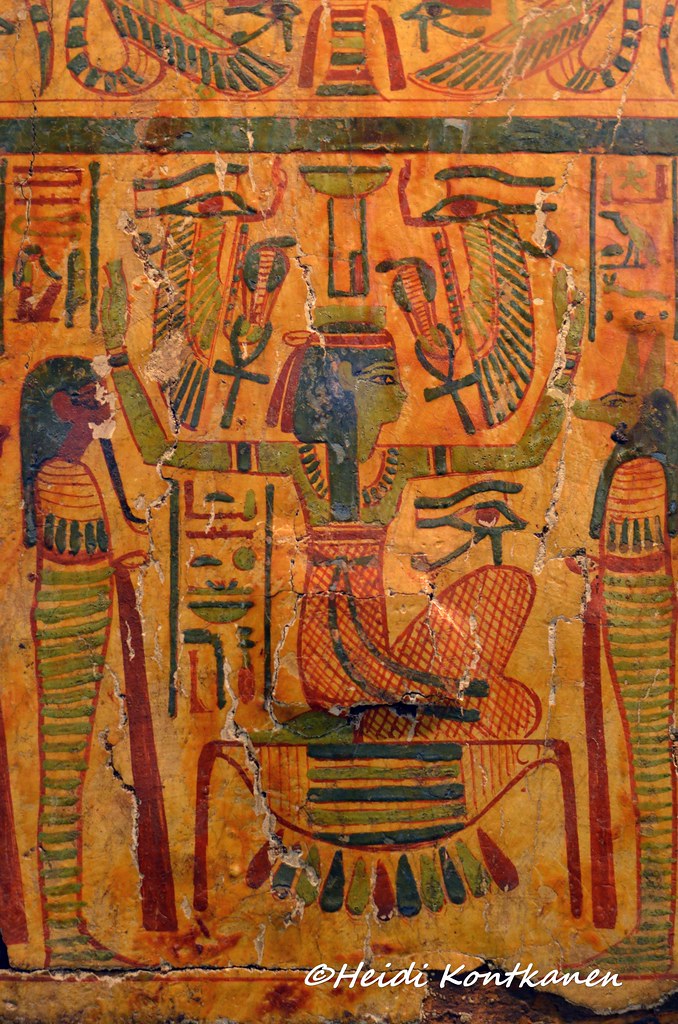#imsety
Text
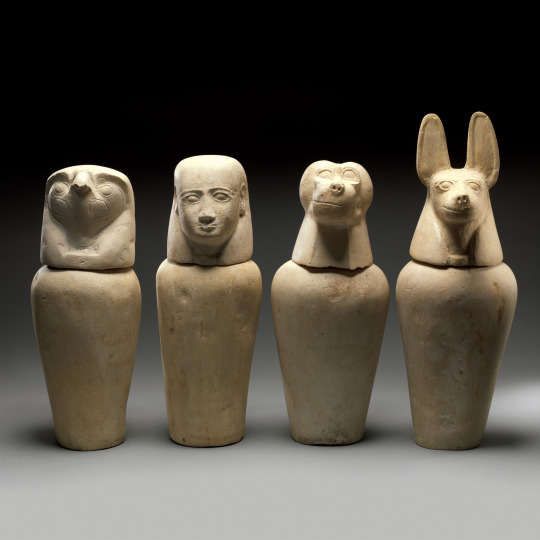
A set of four canopic jars was an important element of the burial in most periods of Ancient Egyptian history. Canopic jars were containers in which the separately mummified organs would be placed. The best known versions of these jars have lids in the shape of the heads of protective deities called the four Sons of Horus. The human-headed Imsety was the guardian of the liver; the baboon-headed Hapy looked after the lungs; the jackal-headed Duamutef was responsible for the stomach; and the falcon-headed Qebehsenuef cared for the intestines. Image by The Metropolitan Museum of Art.
Lean more / Daha fazlası
https://www.archaeologs.com/w/canopic-jar/
#archaeologs#archaeology#archaeological#dictionary#history#art#pottery#canopic jars#egypt#ancient egypt#mythology#the four sons of horus#horus#hapy#duamutef#qebehsenuef#imsety#arkeoloji#tarih#sanat#çömlekçilik#antik mısır#mısır#mitoloji
55 notes
·
View notes
Text
On Padiamun's coffin, The Devourer appears in the form of a dog, sitting at Thoth's feet as he records the result of the judgement. The deceased kneels behind Thoth, holding his heart. Anubis and Maat stand under the scales, and a large snake protecting Osiris in his pavilion rears up in front of Maat. Behind the pavilion we can see Imsety and Hapy, two of the sons of Horus.
Where: Liverpool World Museum
When: Third Intermediate Period, 25th Dynasty
#Ancient Egypt#coffin#Osiris#Anubis#Maat#Imsety#Hapy#The Devourer#Thoth#Liverpool World Museum#Third Intermediate Period#25th Dynasty#Padiamun
13 notes
·
View notes
Text
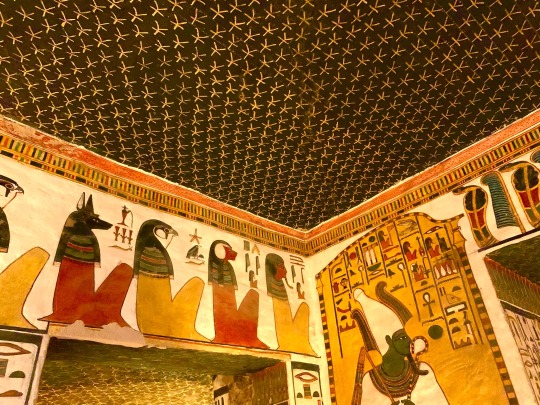
The four sons of Horus, (right to left): Imsety, Hapy, Duamutef and Qebehsenuef, above a doorway in the tomb of Nefertari.
8 notes
·
View notes
Text
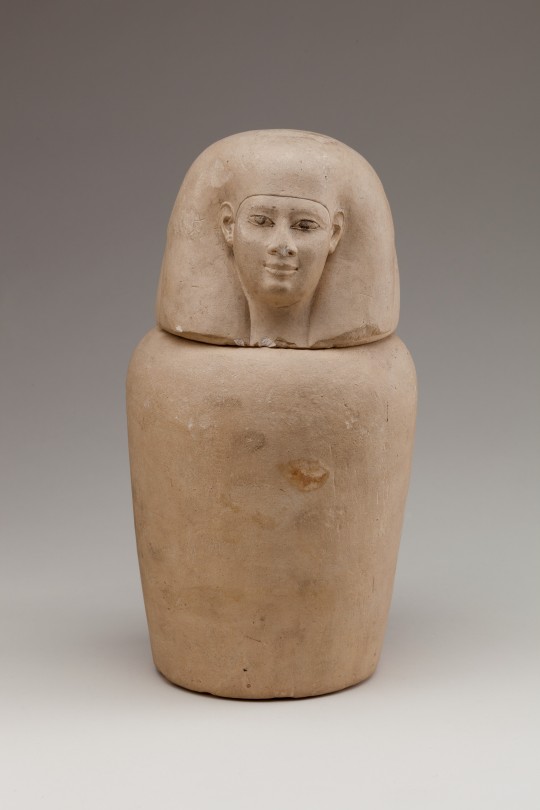
Ancient Egyptian canopic jar (limestone with paint) depicting Imsety, one of Horus' four sons and a human-headed deity who protected the deceased's liver. Artist unknown; 1550-1070 BCE (18th-20th Dynasty, New Kingdom). Possibly from Abydos; now in the Metropolitan Museum of Art.
#art#art history#ancient art#Egypt#Ancient Egypt#Egyptian art#Ancient Egyptian art#Egyptian religion#Ancient Egyptian religion#kemetic#Imsety#canopic jar#sculpture#stonework#limestone#carving#Abydos#New Kingdom#Metropolitan Museum of Art
98 notes
·
View notes
Text



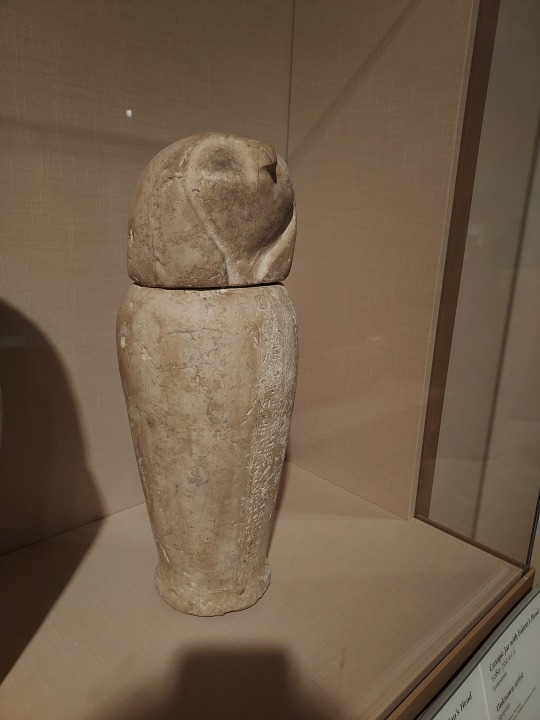
Canopic Jars, 1080-720 B.C.E
Limestone
Egyptian
------------------------------------------
Canopic jars were made to contain the organs that were removed from the body in the process of mummification: the lungs, liver, intestines, and stomach. Each organ was protected by one of the Four Sons of Horus.
Baboon (Hapy) - Held the lungs
Jackal (Duamutef) - Held the stomach
Human (Imsety) - Held the liver
Falcon (Qebehsenuef) - Held the intestines
-Description from The Met
7 notes
·
View notes
Text
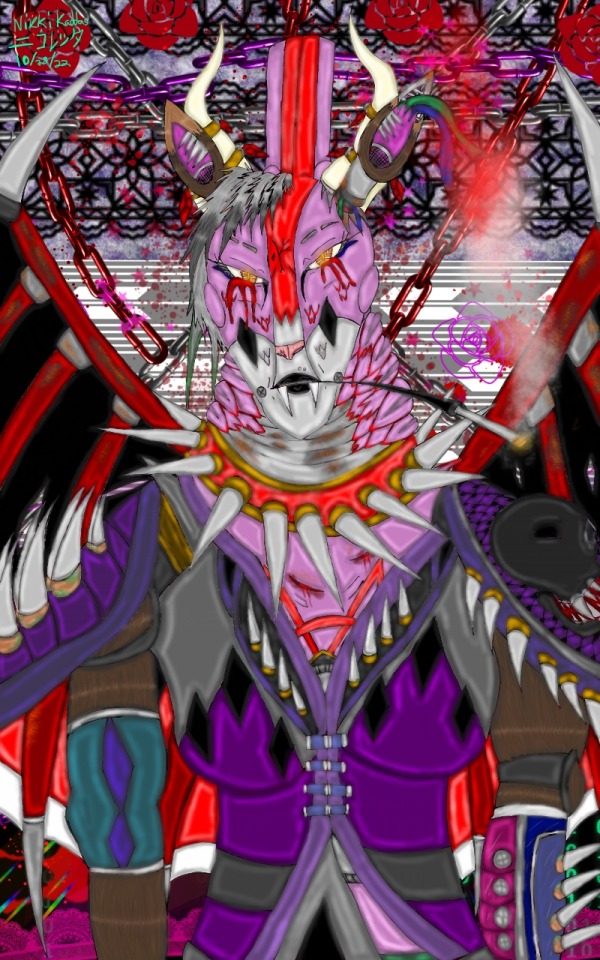
(This literally took me a long time to get this piece out there, mild flash warning for the picture..)
#Imsety Ramgera Durage#Imsety#digital art#art#artist#oc#robot oc#delphinix#tulip dragon#dragon#furry#furry art#furry community#demonically possessed robot#イムセテイ#デルフィニクス#ツリップドラゴン#ドラゴン#ロボット#original character#hello there
2 notes
·
View notes
Text


The Amins were perfect houseguests for the duration of their stay and allowed Agnes and Connor to believe that their own two children may not grow up to be demons.
39 notes
·
View notes
Text

Imsety, Glory of Horus
"If you control 'King's Sarcophagus', you can Special Summon this card (from your GY). You can only Special Summon 'Imsety, Glory of Horus' once per turn this way. You can only use each of the following effects of 'Imsety, Glory of Horus' once per turn. You can send 2 cards from your hand to the GY, including this card; add 1 'King's Sarcophagus' from your Deck to your hand, then you can draw 1 card. If another card(s) you control leaves the field by an opponent's card effect, while this card is in your Monster Zone (except during the Damage Step): You can send 1 card on the field to the GY."
17 notes
·
View notes
Text
Imseti : *clicks pen*
Hapi : *clicks pen in response*
Horus: Stop that.
Imseti: Stop what?
Horus : You’re talking about me in Morse code!
Imseti: Yes dad, that’s what we doing. In our very limited time, we took a class on a very outdated, very unnecessary form of communication just so we could talk about you in front of you. Congrats, you figured us out!
*later*
Hapi, to Kebehsenuef: That’s actually exactly what we were doing.
#Imseti#Hapi#Hórus#egypquotes#incorrect egyptian gods#incorrect egyptian quotes#ancient egypt#egyptian gods#egyptian mythology#incorrect egyptian mythology#Horus has many children and I hope I can use many quotes with them#Kebehsenuef
2 notes
·
View notes
Photo




AN EGYPTIAN POLYCHROME WOOD COFFIN PANEL
LATE PERIOD, 26TH DYNASTY, CIRCA 664-525 B.C.
80 1/4 in. x 17 1/4 in. (204 cm. x 44 cm.).
From the side of a wooden coffin, carved in sunken relief with eight standing deities facing left, wearing a short kilt and holding the was sceptre and the ankh symbol. Each figure is flanked by a column of text, identifying the deceased and each god, from left to righ: 'Shu'; 'Imsety, who gives life (to) P(a)wahibreemakhet', 'Anubis, who is upon his hill (?), Great God, Lord of the Sacred Land (cemetery)', 'Hapy, who gives life (to) P(a)ankhwahibre Wahibreemakhet', 'Osiris, who gives life (to) Ankhpawahibre Wahibreemakhet', 'Kebeh-senuef, who gives life (to) Ankhwahibre', 'Anubis, who is foremost in the God’s Booth, who gives life to Wahibreankh (or Ankhwahibre?)', and 'Isis, who gives life to Wahibreankh (or Ankjhwahibre?) Pawahibreemakhet'.
#AN EGYPTIAN POLYCHROME WOOD COFFIN PANEL#LATE PERIOD 26TH DYNASTY CIRCA 664-525 B.C.#ancient wooden coffin#ancient artifacts#archeology#archeolgst#history#history news#ancient history#ancient culture#ancient civilizations#ancient egypt#egyptian history#egyptian hieroglyphs
283 notes
·
View notes
Text
Welcome to the Black Market
I actually watched episode five of Midnight Museum live-ish, so let's see how my theories unraveled in this episode:
The Lotus

The crescent moon, which symbolizes life and death, showed up several times, but the lotus was also clearly shown which symbolizes rebirth (I couldn't figure out if it was a crown or a lotus before). There is also a smaller crescent moon on top of the lotus.
That bbq body is about to get reborn.
Tarot Cards
Khatha was the Hermit, which I guessed he was the Emperor because of his clothing and position in the poster, but the Hermit would make sense since he mirrored the image when he first encountered Dome in the past but he didn't have a lantern, which is a key element to the Hermit due to his introspection.
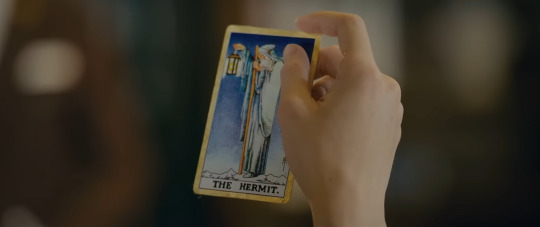
Sidenote: The Emperor and Justice (who I think Khatha and Bam are) conflict with each other because they are two different types of rule and power.
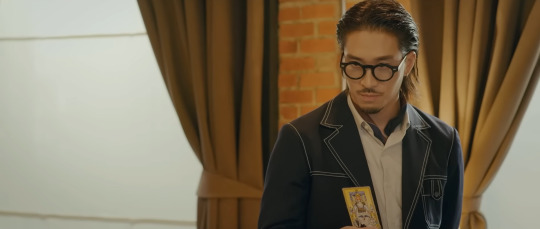
Triphop was the Chariot, which is powerful and represents overcoming difficulties, but...he hid the card, so I still think he is the Hierophant unless that was his grandfather's position.
The High Priestess was the mystery woman.
New God
Last episode, Dome was told something about his mission involving a new god. The High Priestess left behind a bible with her card in it, and she recited Acts 2.19-2.20:
I will show wonders in the heavens above and signs on the earth below, blood and fire and billows of smoke./ The sun will be turned to darkness and the moon to blood before the coming of the great and glorious day of the Lord.
That bbq body is looking more and more godly.
Auction
There are six known Fabergé eggs still missing. They held surprises in them such as pictures or other treasures. The auction featured two because Triphop already lost one, and Khatha was outbid for the other.
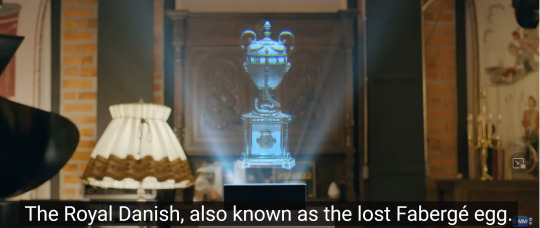
Van Gogh created several sunflowers paintings which were part of a series. There are two known ones missing, but Two Sunflowers is not one.
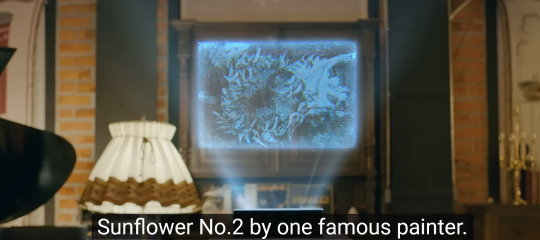
Egyptian canopic jars hold vital organs that were removed during the mummification process. This set features the "four sons of Horus: the baboon 'Hapy,' representative of the North and protector of the lungs; the god 'Duamutef' jackel-headed guardian of the East, who protected the stomach; the hawk 'Qebhsennuf' of the West, protector of the intestines; and the god 'Imsety' of the South, human-headed guardian of the liver." Thank goodness Khatha won this because if homegirl is trying to Frankenstein/Build-a-Bear her way into a god, not having the organs would be a big obstacle.

This is the 1727 'Davidoff, Morini' Antonio Stradivari violin. It was stolen in 1995 from a locked room with no forced entry and hasn't been seen since. Some believe a ghost took it.

Although the the High Priestess bought a lot like Perseus' shield with the head of Medusa

She wasn't there to buy anything. She was there to confirm Khatha has what she needed - Dome, which he did by buying the Onmyōdō necklace. If Dome really is the Magician, he has the power to bring back the bbq body.
Brother?

Nope! We already know they aren't blood related in the past nor the present. Khatha first encounters Dome when his boat drifts to shore. Best Friends Forever maybe, but brothers in the blood-related sense is out the window.
@slayerkitty - Thanks for the heads up as usual, and I'm still rooting for Dome x Khatha. I don't care what this Triphop says.
#Midnight Museum#symbols and theories#tin foil hat time#Khatha x Dome#Brothers?!#Nah#Ain't no other way#They were in love
81 notes
·
View notes
Text
Detail of the inner coffin of Nepawershefyt.
[On a yellow coffin, Nephthys kneels on the hieroglyph for gold, her arms raised above her head. On her left is Imsety and on her right, Duamutef, both as yellow mummies with green stripes. The goddess is green and so is Duamutef's jackal head.]
Where: Fitzwilliam Museum Cambridge
When: Third Intermediate Period, 21/22 Dynasty
#Ancient Egypt#coffin#Nephthys#Imsety#Duamutef#sons of Horus#Fitzwilliam Museum Cambridge#Third Intermediate Period#21st Dynasty#22nd Dynasty#Nepawershefyt
15 notes
·
View notes
Text

I am. SO very close to finishing the introductory slides, but realized I had to fix two wee errors in this clusterfuck reference. Just like the last times, there's a written explanation under the cut qvq
Origin
Nu
[ Atum is fashioned by his parent Nu, but later separates into Amun and Ra ]
First Generation
Amun, first child of Nu and half of Atum
Mut, second child of Nu and Amun's wife
Ra & Apep, twins, third and fourth children of Nu (and, for Ra, half of Amun)
Ptah, fifth child of Nu
Khnum, sixth child of Nu
Thoth, seventh child of Nu
Neith, eigth child of Nu
[ Ma'at and Nehebkau are created by Ra's fire and Apep's blood respectively before the start of the second generation ]
Second Generation
Khonsu, son of Amun and Mut
Tefnut & Shu, twins, second and third child of Ra
Shezmu, born of Apep's blood
Ahti, born of Apep's spit
Babi-Astennu, born of Apep's seed
Hathor-Sekhmet, fourth child of Ra
Heqet, created by Khnum
Hapi & Satet, twins, fifth and sixth children of Ra, Satet is Khnum's wife
Bast, seventh child of Ra
Montu, eigth child of Ra
Third Generation
Anhur, ninth child of Ra
Ammit, born of Apep's bile
Geb, first child of Tefnut and Shu
Nut, second child of Tefnut and Shu, and wife of Geb
Mafdet, adopted by Ra (10th child)
Reshep, foreign god married to Qetesh
Anat & Astarte, twins, foreign goddesses adopted by Ra (11th and 12th children), both married to Set
Mehit, foreign goddess married to Anhur
Qetesh, goddess adopted by Ra (13th child), wife of Reshep
Nefertem, first child of Sekhmet and Ptah's relations
Maahes, second child of Sekhmet and Ptah's relations
Serket, first child of Neith and Khnum
Sobek, second child of Neith and Khnum
Fourth Generation
Min, child of Reshep and Qetesh
Anuket, child of Satet and Khnum
Osiris, first child of Geb and Nut
Horus-Ur, second child of Geb and Nut
Set, third child of Geb and Nut
Isis, fourth child of Geb and Nut
Nephthys, fifth child of Geb and Nut
[ Before the start of the fifth generation; Heka is created by Ma'at and Thoth, Khepri is created by Ra (14th child) and incubated by Thoth, and Hatmehit is created by Abtu the Fish swallowing then spitting out Osiris' penis (which was severed by Set) ]
Fifth Generation
Anubis, child of Osiris and Nephthys' affair
Horus (the Younger), child of Osiris and Isis, and reincarnation of Horus-Ur
Wepwawet, child of Neith and Set's affair
Tutu, child of Neith and a pre-Egyptian settlement hunter
Sixth Generation
Nekhbet & Wadjet, twins, 15th and 16th children of Ra
Kebechet, pupil and unofficially adopted daughter of Anubis
Ahephi, Imsety, Daumutef, & Qebehsenuef, quadruplets, the four sons of Horus and Hathor (via fling with the Elder, marriage with the Younger)
#lore posting#for every time you think this 'wow this is insane'#(which it is you're 10000% correct)#be just as glad as I am I only included the flings that resulted in children. otherwise there would be So Many Red Lines#*points @ Thoth- Isis- and Hathor-Sekhmet in particular*
10 notes
·
View notes
Photo

The Four Sons of Horus from the Tomb of the Pharaoh Ay The images 𓏏𓅱𓏏𓀾𓏪 “twt.w” of the sons are usually depicted in their individual anthropomorphic forms, but in other rare circumstances they are shown in human form. They are all sitting 𓈞𓊃𓀉 “ẖs” on thrones 𓊨𓏏𓉗 “3s.t” and brandishing flail sceptres 𓈖𓐍𓐍𓌅 “nḫ3ḫ3” of kingship. In the center there is an offering table with divine food offering for the gods 𓊹𓊹𓊹 “nṯr.w” Right side: these two figures are wearing the red crown of Lower Egypt/North 𓇾𓇊 “t3-mḥw” and brandishing the flail of kingship. The Ape-headed Hapy 𓐑𓊪𓇌𓀭 The Human-headed Imsety 𓐝𓊃𓍘𓇋𓀭 Left side: these two figures are wearing the white crown of Upper Egypt/Southern 𓇾𓇙 “t3-šmˁ” and brandishing the flail of kingship. The Jackal-headed Duamutef 𓇼𓏏𓅐𓆑𓀭 The Falcon-head Quebesenuef 𓏁𓌢𓏫𓆑𓀭 Center Hieroglyphs: 𓂋𓐍𓏜𓂋𓈖𓏫𓇷𓏏𓊹𓊹𓊹𓀭𓏪 “rḫ rn.w psḏ.t” ‘Knowing the names of the gods of the Ennead’ 📸 kairoinfo4u - Flickr 𓋹𓎬𓋹𓎬𓋹𓎬𓋹𓎬𓋹𓎬𓋹𓎬𓋹𓎬𓋹𓎬𓋹𓎬𓋹𓎬𓋹𓎬𓋹𓎬𓋹𓎬𓋹𓎬𓋹𓎬𓋹𓎬 @egyptologylessons 𓋹𓊽𓋴𓆖𓎛𓇳𓎛 © 𓊁𓊁𓊁𓊁𓊁𓊁𓊁𓊁𓊁𓊁𓊁𓊁𓊁𓊁𓊁𓊁𓊁 #Ancientegypt #ägypten #egyptology #egypte #egitto #egipto #이집트 #pharaoh #tomb #ay #sonsofhorus #tombart #hieroglyphs https://www.instagram.com/p/Cp8LoPAOuRa/?igshid=NGJjMDIxMWI=
#ancientegypt#ägypten#egyptology#egypte#egitto#egipto#이집트#pharaoh#tomb#ay#sonsofhorus#tombart#hieroglyphs
40 notes
·
View notes
Note
Hathor: Horus is a breeder
Horus: No I'm not!!!!
Thoth: You gave her 4 babies on your first try, that's something
this is freaking crazy.. and i didn't realise this when i first read this ask, but there is ACTUAL lore for this:

^^ a cute family pic of Horus' quadruplets, L-R: Imsety, Hapi, Duamutef, and Qebehsenuef.
i mean. it doesn't actually say they're quadruplets but i'm electing to imagine them to be quadruplets because it's infinitely funnier. also, it doesn't say if Hathor's their mother or not, but like. i don't really associate Horus with any other consort besides her, so im choosing to actually believe Anon is RIGHT, and yeah. Hathor and Horus have quadruplets.
also. something really cute i read about them is that all 4 boys are associated with particular organs during the process of embalmment (though it's not specified who's in charge of what) BUT they're also associated with 4 goddesses who are connected with the afterlife too- "usually Isis for Imsety, Nephthys for Hapy, Neith for Duamutef, and Serqet for Qebehsenuef" WHICH i think is super cute.
13 notes
·
View notes


